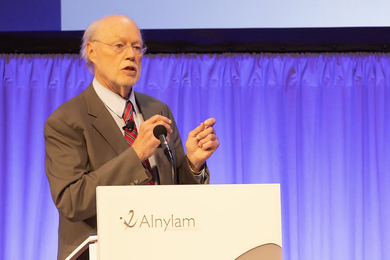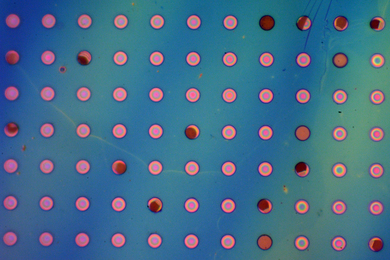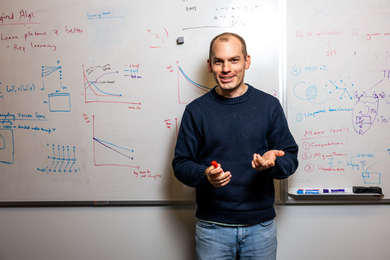The Massachusetts Institute of Technology has traced the effects of government-funded research at MIT in the 20-year- old biotechnology industry, and found that the university-government- biotech partnership has been very fruitful indeed.
The study, " MIT, the Federal Government and the Biotechnology Industry: A Successful Partnership," was released Monday. It shows that:
"The government sponsors basic scientific research in academia totaling some $12 billion annually. The "return" on this investment is manifold and profound: federally funded research advances the scientific and technological base of the nation; it educates and trains future engineers, scientists and managers; it produces remarkable achievements in medicine and health care; and it spawns thousands of high tech start- up companies which build industries and strengthen the nation's economy," the study said.
"The federal government is the largest source of funding for biotechnology-related research at MIT. It is the engine that drives scientific discovery and technology development in biotechnology in MIT labs, and ultimately, in the larger biotechnology industry.
"Of the approximately $85 million in research that is conducted annually in the life sciences at MIT, about $75 million, or 88%, is federally sponsored. A considerable portion of that federally funded research - approximately $43 million in 1995, supporting 138 research projects - is done in the MIT Biology Department, the MIT Center for Cancer Research and the Whitehead Institute for Biomedical Research and is directly applicable to biotechnology. Primary funding agencies include the National Institutes of Health and the National Science Foundation."
MIT scientists have done pioneering work in molecular biology and genetic engineering, the basis of biotechnology, and in closely related fields such as immunology, virology and genetics. They:
"The development of the U. S. biotechnology industry is the result of a partnership of universities, the Federal government and biotechnology companies. The government provides crucial funding for basic biological research in universities, approving research proposals based on scientific merit and peer review. University research, in turn, provides the scientific basis for the development of life-saving medical products by biotechnology companies.
"As a potential new economic engine for the country and as a source of medical advances, biotechnology may be essential to the economic vitality and physical well-being of the next generation of Americans.
"MIT has had a profound impact on the biotechnology industry and continues to lead it forward in many dimensions."
MIT educates and trains future scientists, engineers and managers in biotechnology, advances the scientific and technological base of the nation, and spawns biotechnology companies which have become industry leaders as well as leading-edge niche market specialists, the report said.
"The intellectual vigor and scientific excellence of MIT's graduating students and research scientists play a vital role in the biotechnology industry. From the ranks of the Biology Department's 20-25 yearly Ph.D. graduates and nearly 150 postdoctoral research scientists, and from other MIT departments and schools, a skilled pool of biologists, chemists, biochemists, process engineers and others brings advanced knowledge and training to U. S. biotechnology companies.
"MIT's influence on biotechnology companies is felt in management as well; graduates of the Sloan School of Management hold senior management positions in many Massachusetts and national biotechnology companies," the study said.
The MIT-Related Companies with 9 Top Drugs
The MIT-related companies, with nine best-selling biotech drugs in 1994, include:
The late Salvador Luria , a pioneer in viral genetics in the 1940s and 1950s, discovered how genes mutate and did important work in the genetic structure of viruses. He was a co-recipient of the Nobel Prize in Medicine and Physiology in 1969. His research laid the foundation for later research in the structure of genes that made the biotechnology revolution possible.
H. Gobind Khorana shared the Nobel Prize in 1968 for his contribution to the elucidation of the genetic code, the "blueprint" of life. His research explained how messages inscribed in genes are translated into the structure of enzymes and proteins. Later work in Khorana's laboratory led to the first complete synthesis of a gene in a fully living cell, a signal achievement which established the foundation for the biotechnology industry.
David Baltimore 's discovery in 1970 of reverse transcriptase, an enzyme that catalyzes the conversion of RNA to DNA, advanced the means of DNA synthesis and helped form the basis of modern genetic engineering, the workhorse of biotechnology. Baltimore shared the Nobel Prize in 1975 for this discovery. Baltimore's later work in retrovirus vectors fundamentally contributed to the development of gene therapy, the "second generation" of the biotechnology revolution with great potential for treating diseases at their root, genetic level.
Susumu Tonegawa revolutionized our understanding of the genetic basis of the immune system. His work described how genes in cells recognize and fight off foreign invaders like bacteria, viruses and cancers. This helped scientists to control and manipulate the immune system, and laid the foundation for a whole range of therapeutic approaches in fighting disease, many of which are derived from biotechnology. Tonegawa was awarded the Nobel Prize in 1987.
Phillip Sharp was named co-recipient of the Nobel Prize in 1993 for his work in the 1970s in understanding the basic structure and function of genes. Sharp's discovery of RNA splicing led to a radical revision in understanding how genes send instructions to cells to create proteins, the building blocks of life. The Nobel Committee noted that Sharp's work led to a consensus that some of the 4,000-5,000 known inherited diseases in humans are due to mutations in the gene splicing process. Sharp's research advanced the revolution in biotechnology by shedding light on the arrangement and reproduction of DNA.
The study, " MIT, the Federal Government and the Biotechnology Industry: A Successful Partnership," was released Monday. It shows that:
- Five MIT professors have won the Nobel Prize in Medicine and Physiology since 1968 for basic discoveries that have been of fundamental importance to biotechnology.
- Nine of the top ten best-selling biotech drugs in 1994 were developed by three companies that were founded or co-founded by MIT alumni or faculty. These drugs treat heart attacks; cancer; leukemia; viruses; infections from chemotherapy, infectious diseases, and AZT treatment of AIDS; anemia; diabetes; hepatitis; growth hormone deficiency; Kaposi's sarcoma, and other diseases.
- Forty-five biotechnology companies in the United States are MIT- related — they were founded or co-founded by MIT alumni or faculty, or they have licensed technology patented by MIT. These companies employ nearly 10,000 people and produce aggregate annual revenues of $3 billion, almost a quarter of the total annual revenues ($12.7 billion) of all U. S. biotechnology companies.
- Thirty biotech companies founded in Massachusetts are MIT-related. They have created more than 3,200 jobs and had annual revenues of $520 million in 1994. Eighteen of the companies are based in Cambridge.
- Massachusetts, with its high concentration of research institutions, has 155 biotech companies, the second-largest concentration of biotechnology firms in the country.
- The government awards 30 to 40 biotechnology patents to MIT each year.
- More than 100 license agreements have been negotiated between MIT and biotechnology companies since 1986. These licensee companies have attracted more than $630 million in development capital and employ 1,200 people.
"The government sponsors basic scientific research in academia totaling some $12 billion annually. The "return" on this investment is manifold and profound: federally funded research advances the scientific and technological base of the nation; it educates and trains future engineers, scientists and managers; it produces remarkable achievements in medicine and health care; and it spawns thousands of high tech start- up companies which build industries and strengthen the nation's economy," the study said.
"The federal government is the largest source of funding for biotechnology-related research at MIT. It is the engine that drives scientific discovery and technology development in biotechnology in MIT labs, and ultimately, in the larger biotechnology industry.
"Of the approximately $85 million in research that is conducted annually in the life sciences at MIT, about $75 million, or 88%, is federally sponsored. A considerable portion of that federally funded research - approximately $43 million in 1995, supporting 138 research projects - is done in the MIT Biology Department, the MIT Center for Cancer Research and the Whitehead Institute for Biomedical Research and is directly applicable to biotechnology. Primary funding agencies include the National Institutes of Health and the National Science Foundation."
MIT scientists have done pioneering work in molecular biology and genetic engineering, the basis of biotechnology, and in closely related fields such as immunology, virology and genetics. They:
- made major contributions to the elucidation of the genetic code, the "blueprint" of life, and to our understanding of the structure and functions of genes, the framework out of which biotechnology developed.
- were instrumental in the development of recombinant DNA technology, the basis of genetic engineering.
- contributed fundamentally to the development of the second generation of the biotechnology revolution — gene therapy — for treating diseases at the genetic level.
- were key contributors in the identification of the genes responsible for Huntington's Disease and Lou Gehrig's Disease.
- identified the first tumor suppresser gene, a vital step in the battle against cancer.
- have shed new light on the genetic basis of cancer and created novel vaccine strategies for cancer and AIDS.
"The development of the U. S. biotechnology industry is the result of a partnership of universities, the Federal government and biotechnology companies. The government provides crucial funding for basic biological research in universities, approving research proposals based on scientific merit and peer review. University research, in turn, provides the scientific basis for the development of life-saving medical products by biotechnology companies.
"As a potential new economic engine for the country and as a source of medical advances, biotechnology may be essential to the economic vitality and physical well-being of the next generation of Americans.
"MIT has had a profound impact on the biotechnology industry and continues to lead it forward in many dimensions."
MIT educates and trains future scientists, engineers and managers in biotechnology, advances the scientific and technological base of the nation, and spawns biotechnology companies which have become industry leaders as well as leading-edge niche market specialists, the report said.
"The intellectual vigor and scientific excellence of MIT's graduating students and research scientists play a vital role in the biotechnology industry. From the ranks of the Biology Department's 20-25 yearly Ph.D. graduates and nearly 150 postdoctoral research scientists, and from other MIT departments and schools, a skilled pool of biologists, chemists, biochemists, process engineers and others brings advanced knowledge and training to U. S. biotechnology companies.
"MIT's influence on biotechnology companies is felt in management as well; graduates of the Sloan School of Management hold senior management positions in many Massachusetts and national biotechnology companies," the study said.
The MIT-Related Companies with 9 Top Drugs
The MIT-related companies, with nine best-selling biotech drugs in 1994, include:
- Amgen, Inc., which developed Neupogen, Epogen and Procrit. Neupogen boosts white blood cell production and combats infection from chemotherapy, bone marrow transplants and infectious diseases. Epogen is a recombinant human hormone which stimulates red blood cell production for treatment of anemia. Procrit treats anemia associated with chemotherapy and AZT treatment of AIDS.
- Biogen's Intron A alpha interferon is sold in more than 60 countries for 17 different types of cancers and viral infections, including hepatitis B and C, for which it is the primary treatment. Hairy cell leukemia and Kaposi's sarcoma, an AIDS-related cancer, are among the diseases currently being treated by Intron-A alpha interferon.
- Genentech, Inc., figures prominently, with five of the top ten biotech drugs. Its therapeutics treat diabetes (Humulin), hepatitis B (Engerix-B), heart attacks and blood clots (Activase), human growth deficiency (Protropin), and hairy cell leukemia and Kaposi's sarcoma (Roferon-A), among other disorders. Genentech is a pioneer and leader in the biotechnology revolution: the San Francisco-based company was the first major biotechnology company to be formed, in 1976.
The late Salvador Luria , a pioneer in viral genetics in the 1940s and 1950s, discovered how genes mutate and did important work in the genetic structure of viruses. He was a co-recipient of the Nobel Prize in Medicine and Physiology in 1969. His research laid the foundation for later research in the structure of genes that made the biotechnology revolution possible.
H. Gobind Khorana shared the Nobel Prize in 1968 for his contribution to the elucidation of the genetic code, the "blueprint" of life. His research explained how messages inscribed in genes are translated into the structure of enzymes and proteins. Later work in Khorana's laboratory led to the first complete synthesis of a gene in a fully living cell, a signal achievement which established the foundation for the biotechnology industry.
David Baltimore 's discovery in 1970 of reverse transcriptase, an enzyme that catalyzes the conversion of RNA to DNA, advanced the means of DNA synthesis and helped form the basis of modern genetic engineering, the workhorse of biotechnology. Baltimore shared the Nobel Prize in 1975 for this discovery. Baltimore's later work in retrovirus vectors fundamentally contributed to the development of gene therapy, the "second generation" of the biotechnology revolution with great potential for treating diseases at their root, genetic level.
Susumu Tonegawa revolutionized our understanding of the genetic basis of the immune system. His work described how genes in cells recognize and fight off foreign invaders like bacteria, viruses and cancers. This helped scientists to control and manipulate the immune system, and laid the foundation for a whole range of therapeutic approaches in fighting disease, many of which are derived from biotechnology. Tonegawa was awarded the Nobel Prize in 1987.
Phillip Sharp was named co-recipient of the Nobel Prize in 1993 for his work in the 1970s in understanding the basic structure and function of genes. Sharp's discovery of RNA splicing led to a radical revision in understanding how genes send instructions to cells to create proteins, the building blocks of life. The Nobel Committee noted that Sharp's work led to a consensus that some of the 4,000-5,000 known inherited diseases in humans are due to mutations in the gene splicing process. Sharp's research advanced the revolution in biotechnology by shedding light on the arrangement and reproduction of DNA.





